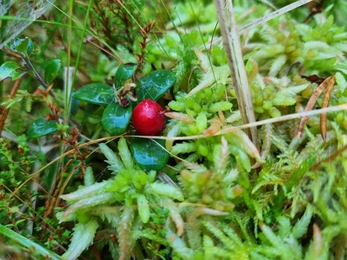Bog woodland is an open woodland with scattered trees across the bog. Bog woodlands develop on acidic, nutrient-poor peat in ombrotrophic (precipitation-fed) peatlands. The lack of nutrients in peat slows the growth of the trees that can survive in these conditions. The dominant species are Scots pine (Pinus sylvestris) and downy birch (Betula pubescens); less common are broadleaved species such as willow (Salix) and alder buckthorn (Frangula alnus). Although stunted and small, the oldest trees in a bog woodland in Scotland are estimated to be 350 years old.1
The stunted trees often occur sparsely because the wet surface offers few drier spots and hummocks for them to establish. The slow growth rate and sparse coverage of trees does not allow them to dry out the habitat or interfere with the accumulation of peat. It is common to see standing and fallen dead trees in bog woodland, often where the weight of the tree has depressed the peat surface, which has led to waterlogging and death. In true bog woodlands, this stable ecological relationship maintains the trees as well as the typical low-lying bog vegetation (e.g. Sphagnum mosses, sedges, bilberries) that carpets the undergrowth.
True bog woodlands are rare in the UK and the habitat is in an unfavourable conservation status for the UK and large parts of Europe. The main threats and causes of habitat loss come from peatland drainage from human activity. Bog woodland is listed as a habitat that has priority conservation status under the EU Habitats Directive.2
Old growth bog woodland in the UK is mainly limited to Scotland. Some known sites are in Northeastern Scotland, such as Inshriach, Abernethy and Mineral Well in Rothiemurchus forest in the Cairngorms, as well as Ballochbuie, Pitmaduthy Moss and Monadh Mor further north. Elsewhere in the UK, bog woodland can be found in the Dorset Heaths and Studland Dunes in Dorset and Somerset, in the New Forest in southern England and in Peatlands Park in Northern Ireland. However, our current knowledge of the distribution of bog woodlands in the UK is still limited.1
Bog woodlands are more common in other parts of northern-, central- and eastern Europe, particularly in Fennoscandia.
Finding trees on peat does not necessarily make the habitat a bog woodland. True bog woodlands are different from forested bogs, and the latter is a more common habitat in the UK. If changes to the hydrological regime of a bog result in drainage and drying, trees may naturally colonise the dry peat, or trees may be planted for commercial forestry. Both lead to further drying of the habitat, which eventually causes the loss of typical bog vegetation. Forest-to-bog restoration is increasingly being undertaken in previously drained and afforested UK peatlands to restore the hydrological regime and the functioning of the peatlands damaged by such management techniques.
*We thank the Wet Woodland Research Network for their valuable input.
References
1 JNCC. 91D0 Bog woodland [Internet]. 2019 [cited March 2025]. Available from: Bog woodland (Bog woodland) - Special Areas of Conservation
2 EUNIS. Bog woodland [Internet]. 2019 [cited March 2025]. Available from: EUNIS -Factsheet for Bog woodland


